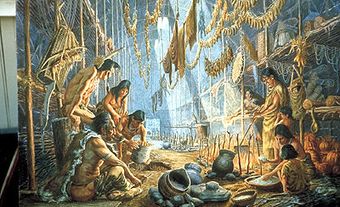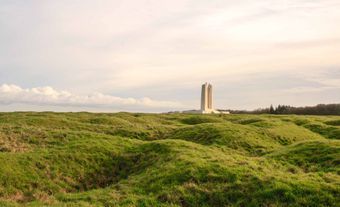Monument
A monument is normally a freestanding, large-scale structure, often artistically embellished, which has as its primary function the commemoration of persons, events or concepts believed to have sufficient importance to merit a public, visible and permanent tribute.
Pre-Confederation
Prior to Confederation, 1867, only a small number of major public monuments were erected. The majority of these were dedicated either to monarchs (Louis XIV at Québec City in 1686, and George III at Montréal in 1773), or to military heroes, such as the column dedicated to Lord Nelson (Montréal, 1809), the obelisk jointly commemorating Wolfe and Montcalm (Québec City, 1828), and the imposing memorial to Sir Isaac Brock (Queenston Heights, UC, first built c1830). Not all, however, have survived intact: the monument to George III, for example, was apparently deliberately destroyed c 1775. The first monument to Brock was tampered with twice by saboteurs linked to the Rebellions of 1837, the second time seriously: the damage done to the monument in 1840 by an explosive device led to its eventual rebuilding in 1853.
Confederation to Centennial (1867-1967)
In the 100 years following Confederation, the focus of the monument shifted still further toward the commemoration of specific persons, especially those who had shaped both the political and the cultural history of Canada. In cities across the country, as well as in the federal and provincial capitals, monuments were erected to such diverse figures as early explorers and prime ministers, pioneer settlers and provincial premiers, and outstanding citizens from varying walks of life. Along with this change of focus came a change of format: the predominantly architectural monuments of the pre-Confederation era gradually ceded place (though never entirely) to bronze statuary, while professionally trained sculptors, increasingly Canadian-born, gradually supplanted the military officers, engineers and architects who had designed the earlier memorials. An attempt was even made to create a Canadian version of the Statue of Liberty: when plans for a colossal "Angel of Welcome and Peace" at Québec City failed, the federal government erected instead an imposing monument of Madeleine de Verchères at Verchères, Québec, intended both to greet and to inspire new immigrants to Canada as they arrived by the St Lawrence River.
The War Memorial
By far the most ubiquitous monument in Canada is the memorial dedicated to the war dead of WWI. Although monuments had been erected earlier to the North-West Rebellion and the South African War, they were often elaborate in design and few in number, while after WWII peacetime facilities for the living, such as memorial arenas, were often preferred as tributes. (One of the notable exceptions is the Ottawa Memorial, erected by the Commonwealth War Graves Commission in memory of the airmen who died in WWII, and for whom there is no known grave.)
In contrast, the memorials erected in cities and towns across Canada to the fallen of WWI are both more numerous and more widely varied in form. They range from a simple cairn or cut-stone cenotaph to memorial arches, gates and towers, and from memorial avenues of trees to winged female figures extending laurel wreaths of victory to the uniformed soldiers below. The most common memorial, however, is that of the single soldier of bronze or stone, often sited near the railway station from which so many young men left.
The Monument in Transition (1967 to the present)
While some traditional monuments were still erected during the 1960s and 1970s, such as the statues of Louis St. Laurent in Ottawa and Queen Elizabeth II in Winnipeg, there was a greater tendency to innovate with both style and meaning. On occasion, the more experimental artistic styles then being used in much public art and outdoor sculpture were adapted to commemorative purposes (with varying degrees of public acceptance), as in the monuments to Louis Riel in Regina and Winnipeg, or in the series of special markers erected by Environment Canada, Parks to such figures as Vilhjalmur Stefansson (Arnes, Manitoba), the Rt Hon Alexander Mackenzie (Sarnia, Ontario) or Captain George Vancouver (Vancouver).
In other instances, a new type of monument flourished: while large in scale and symbolic in purpose, they are usually brightly coloured, have easily identifiable motifs, and are made of unusual materials (examples would include the Pysanka at Vegreville, Alberta, and the Canada Goose at Wawa, Ontario). In the 1980s, however, another trend emerged, with the erection of such monuments as the Guelph fountain in honour of "The Family" or the Ottawa portrait statues of John Diefenbaker and Terry Fox. Many Canadian communities expressed their desire to honour traditional values once again in traditional ways. See also Historic Site.

 Share on Facebook
Share on Facebook Share on X
Share on X Share by Email
Share by Email Share on Google Classroom
Share on Google Classroom





